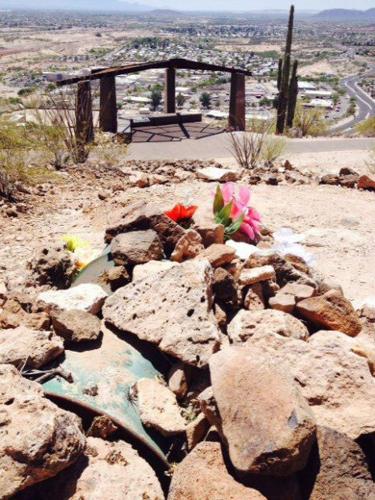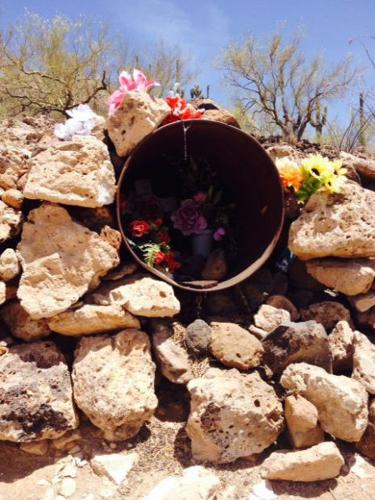I wonder who was Esther G. Castro. Also what was Oscar Elias like?
Two unknown people but certainly not to someone or their families who made small but visible efforts to remember them in special ways: Castro and Elias are commemorated in two small shrines along the new walking paths in Sentinel Peak Park.
A small brown wood cross bears the name of Elias and the years he lived, 1933-2012. A few yards away, Castro’s name and 1940-2001 are printed on a yellow heart planted in a bouquet of white, pink and yellow plastic flowers at the foot of a saguaro which looks like a sentinel. Attached to the display is a yellow fuzzy Easter basket.
The memorials are visible cultural landmarks of our Southern Arizona landscape. The organic monuments come in all shapes, colors and sizes. There are the “ghost bikes” or wreaths and crosses on the roadside to mark a spot where someone died. Some shrines also mark the completion of a manda, a promise made by the living to the dead.
The “A” Mountain shrines and all others are part of our “ritual genes,” said Maribel Alvarez, anthropologist, folklorist and associate professor with the Southwest Center at the University of Arizona.
Since ancient times people have marked public spaces, left traces and told stories of our humanity, said Alvarez, who also doubles as the annual Tucson Meet Yourself festival program director.
From cave drawings to petroglyphs to roadside shrines, there is a universal thread. “It’s innate ... It’s very common to the human nature,” she said.
It didn’t take long for the unobtrusive shrines to appear on the new addition to “A” Mountain. The paths, two ramadas and interpretive signs about the history of Sentinel Peak were installed as part of last summer’s $320,000 park improvements on the hill’s southern face.
In addition to the shrines to Castro and Elias, there is a third one but it is dedicated to no one specifically. It is a green metal barrel, which looks like the trash containers found in the city’s parks. The shrine-in-a-barrel is embedded partially into the ground and covered by the black volcanic rocks. Plastic flowers and a black rosary adorn the shrine. A partially burned candle with the image of Christ is nestled in a rocky nook.
I wondered if “A” Mountain, which is considered the birthplace of Tucson, had been a special place for Elias and Castro. Maybe their homes can be seen from that side of the Tucson landmark, which the city acquired in 1928 .
Alvarez said the practice of erecting shrines is a practical function for people who create them, especially for those who grieve. It is a way to express outwardly the internal sorrow over loss. It also is a public expression of the joy of the life the deceased person lived, added Alvarez.
“It’s unique here. We do it with flair, with gusto, with ganas,” she said.
While the shrines are steeped in our regional culture and history, some also reflect a religious aspect, which sometimes creates friction.
Last June a Wisconsin organization asked the city to remove a shrine to Our Lady of Guadalupe which sits in a nicho on the southeast slope of “A” Mountain.
The Freedom From Religion Foundation argued that allowing the two-decade-old shrine, erected by a Tucsonan, to remain on city property constituted city endorsement of religion.
The presence of the religious shrine would open the door to other religious symbols on public property, the Foundation asserted.
The city responded that the Guadalupe shrine would not be removed because it did not pose a threat to public safety or health.
City Councilwoman Regina Romero, whose Ward 1 includes “A” Mountain, said the city has respect for these symbols of our culture and history. The shrines go beyond reflecting religious beliefs. They are reflections of us.
The shrines are a marriage of traditions handed down through our history and traditions from all corners of the globe.
“It’s a part of where we live,” Romero said.








